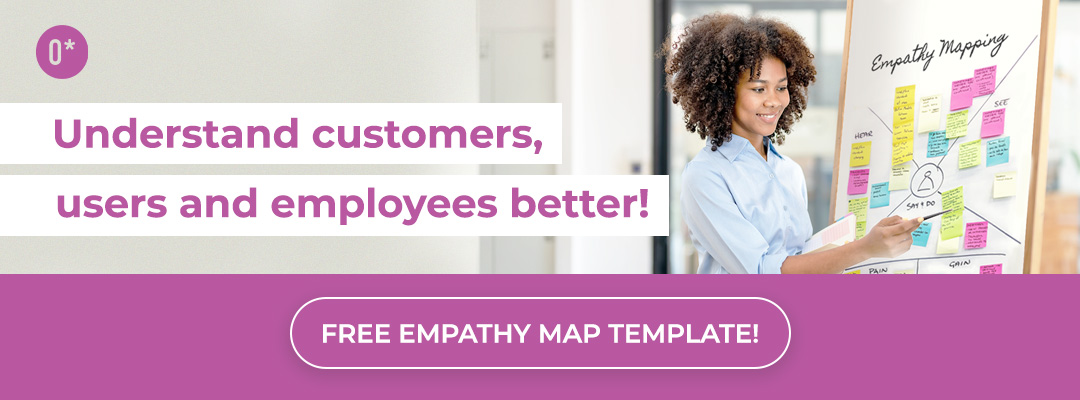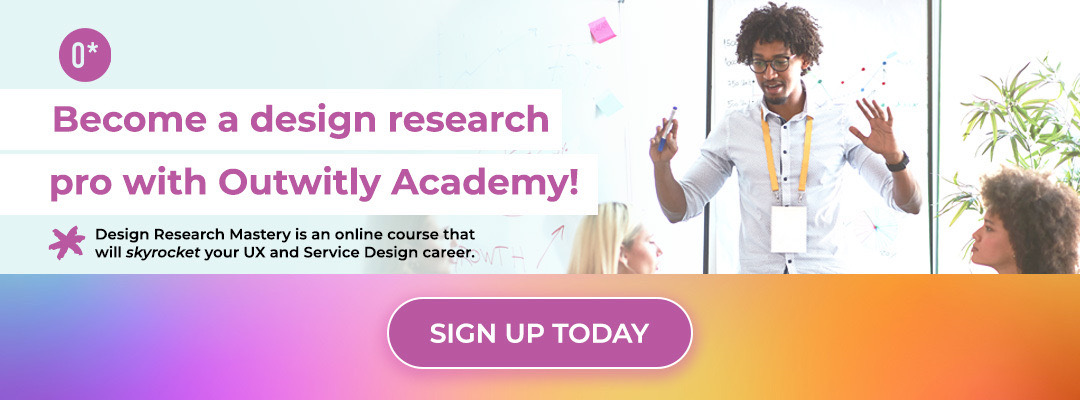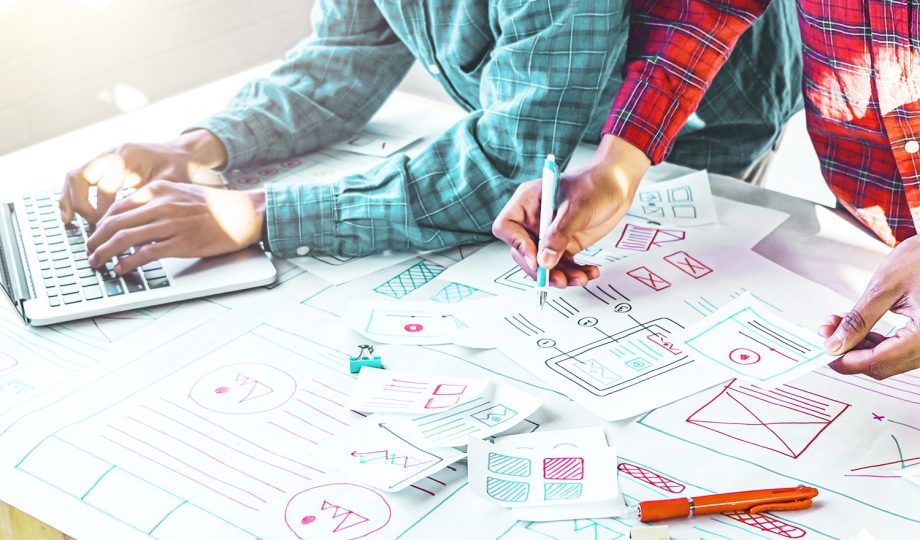
In the world of UX and service design, inspiration is an absolute must-have for every practitioner. We all rely on the ability to dream up amazing problem-solving ideas, whether that’s our own ability, or the ability of other teammates we’re leaning on to pass the torch.
But what happens when inspiration runs out? What about those times when our teammates are counting on us to deliver, and we’re missing that much-needed creative spark? We’ve definitely been there, and we know how lonely that feeling is. That’s why today’s blog is focused on finding inspiration through teamwork!
In Part 1 of our blog series on unblocking creativity, we talked about the most common ways that individual UXers get creatively stuck, how to get unstuck, and our favourite strategies for finding creative flow from a solo perspective. In Part 2 below, we’ll be covering:
- How to Help Your UX Team Get Inspired
- Personal Inspiration Tips from the Outwitly Team
This collaboration-based strategy list should fuel your creative fire AND help you do the same for your colleagues!
How to Help Your UX Team Get Inspired
Working with colleagues who have varying perspectives can make it easier to get new ideas going, but sometimes, for whatever reason, the dynamic between collaborators gets thrown off, and discouragement becomes contagious. Soon, major UX and HCD roadblocks are created, and design projects can grind to a halt. So, how do we help this?
A lot of people think of inspiration (or the lack of it) as a magical, mysterious force that nobody can control. In reality, we’ve found that a lack of inspiration can be caused by very specific, concrete problems, and luckily, these concrete problems can be solved!
In this section, we’ve outlined the most common ways teams can lose inspiration and our suggestions for overcoming them. Let’s get started.
If you’re lacking…
1. User Empathy:
Bill Buxton, Partner Researcher at Microsoft Research, was quoted saying, “The best products are born from a deep empathy with the people who use them.” While this idea might seem obvious to many of us in UX and service design work, it’s surprisingly easy to forget in high-pressure environments or in situations with competing priorities.
View this post on Instagram
Teams struggling to find inspiration through empathy might be getting lost in:
- Client expectations: When an organization has low UX maturity, its stakeholders might be under time pressure, and they might favour a feeling of quick accomplishment over a research-based, human-centered design process. When you’re servicing a client in this situation, it’s hard to resist falling into the same mindset.
- Previous experiences: If your teammates have worked on a similar project before, they might think they already understand the users their current project is geared towards. Assumptions like this can interrupt design thinking and they can lead to copycat designs. The truth is, users are changing all the time!
- Stereotypes: In cases where you don’t have much in common with your users, you’re more likely to self-edit or veto great ideas because of subconscious assumptions about those users. We’re all exposed to so many stereotypes in everyday life (through TV, social media, etc.) that we can internalize them.
Try…
Creating Empathy Maps:
An empathy map is a great visualization tool that helps design researchers and practitioners put themselves into the shoes of different user groups or personas. It’s an exercise best done as a team, and it involves brainstorming and mapping out all of the different things that users see, hear, think and do when interacting with a product or service.
Your empathy map should be a chart with four quadrants for each of the four categories, with your persona in the centre. You can use a whiteboard and post-its, or you can use a web-based tool if you’re holding a virtual empathy map workshop!
This exercise is a great way to get your team thinking about their users as real, three-dimensional humans with complex needs and emotions. (For more info on empathy maps, see our blog post dedicated to empathy mapping and proto-personas.)
If you’re lacking…
2. Research Time:
Even if you have a wonderful project management team that gives you lots of leeway for getting design research done, external and unexpected issues can still arise: user recruitment can be harder than usual, bad weather can derail an observations field trip, interviewees can no-show… The list goes on!
So, what to do when you’re running out of time with plenty of users left to talk to? Or worse, you’re running out of time before you even start? And what if that time pressure is making your team cut corners, interrupt users during in-depth interviews and is ultimately sucking the inspiration out of your research?
Try…
Sending Cultural Probes:
A cultural probe can take many forms, but in a nutshell, it’s a “homework” assignment and a reflection exercise that a researcher sends their participants to help them express their deeper feelings and reactions in relation to a product or service. It falls under the qualitative research umbrella. You can think of it as a small, simplified, single-submission version of a diary study.
For example, you might ask participants to send you web-sourced images that sum up their feelings about specific steps or overall processes. Or you might ask them to describe their interactions with a product in single-sentence answers, analogies or even single words.
We love cultural probes because they allow us to prime research participants for deeper, more reflective, more efficient and more inspiring conversations or interactions with researchers. We get more context going into the field, which can help us reframe or reprioritize our questions and goals ahead of time and get more actionable insights out of less time.
Go ahead and give them a try! Or if you’ve used cultural probes before, why not test out a different format to keep things fresh?
(NOTE: You can learn even more about cultural probes, actionable insights and problem-solving for research delays in Outwitly Academy’s course on design research. Click below to sign up!)
If you’re lacking…
3. Stakeholder Engagement:
Engaging your stakeholders in your UX and service design processes can help you reduce obstacles to your work, build trust with client teams and decrease your risk of creeping out of scope or otherwise misaligning with company goals. (This is especially useful if you’re working on service design projects in government!)
When your stakeholders are aligned with and involved in your goals, the path to great ideas can be much clearer, and a feeling of inspiration can spread throughout teams. When they’re disengaged — either because they’re too busy, they don’t have an interest in your work, or they’re actively opposing it — inspiration can fizzle out.
Try…
Holding Co-Design Workshops:
Also called “design jams,” co-design workshops are sessions where UX or service design team members in different roles come together to brainstorm solutions/answers to a set of user problems/needs. They can be one-time workshops, but ideally, they should be held more than once throughout a project. And the more diverse the participants, the better — invite your researchers, designers and especially your stakeholders!
If your stakeholders know they can be useful and contribute to the meeting in a specific way, they’re more likely to prioritize your meeting and get involved in the conversation.
We recommend breaking your participants up into separate groups so that everyone can get a voice. There are tons of different co-design workshop formats and activities that you can use to trigger ideation, like games, paper prototyping and storyboarding. Make sure to choose something your stakeholders will enjoy, and choose a facilitator who knows how to run a great design workshop!
If you’ve held a co-design workshop before but inspiration was lacking, try these tips for your next one:
- Assign pre-work: If you’re anticipating a tough crowd, some prompting questions sent through ahead of time can give your participants more time to think and prepare.
- Reverse brainstorm: If people get stuck in negative thinking, use this to your advantage! Get them to think of ways your users’ problems could worsen, then reverse those ideas.
- Do some brainwriting: If everyone is shy and quiet, have them write down their ideas, then pass their paper or document along to the next person to add to, and so on, until it’s gone through the whole group. At the end, read out all of the different idea chains.
Still not convinced? Check out the Outwitly design jam case study (“Example #1”) in this blog post on service design, UX and HCD!
Personal Inspiration Tips from the Outwitly Team
Fun fact: The Outwitly team actually came up with the concept for this blog series together because we wanted to swap and share our strategies for getting inspired.
That’s why we’re excited to cap off today’s blog with a sounding board of team wisdom directly from our Outwitlians. We asked four of them the same question: “How do you find inspiration in your work?” Let’s take a look at what they had to say!
Meet: Kristin Swan

Time in your career: 15+ years
Different roles you’ve held: Manager of Strategic Design, Senior Service Designer, PMO Lead, Senior Program Manager, Business Manager
Education: Masters of Business Strategy, Global Design Innovation and Design for Government Program Graduate (Aalto University), Bachelor’s in Business & Economics (Manufacturing and Supply Chain Management)
How do you find inspiration in your creative work? As a service designer and team leader, I am always looking for inspiration in the facilitation of meetings, discussions, workshops, and presentations, basically for any interaction between individuals that I will lead. I think it’s really important to keep teams engaged, conversations open, and ideas flowing regardless of the group or meeting purpose. I get a lot of inspiration from expert facilitators of different fields, for instance, facilitation for decision making, community engagement (through Reflection Facilitation), consensus building, mediation, focused conversations (using The ToP focused conversation model), and more.
Key takeaway: See, read, analyze and discuss what experts and peers are saying!
Meet: Amy Sullivan

Time in your career: 6 years
Different roles you’ve held: User Experience Researcher, Senior UXR, User Experience Research Lead, Service Designer
Education: Honours Bachelor’s of Art in History and Art History, Masters of Digital Experience Innovation
How do you find inspiration in your creative work? I fully subscribe to the idea that creativity can be taught, and as a Service Designer, I’m familiar with many frameworks and tools to teach people to diverge. When it comes to finding inspiration to be creative in my work, sometimes I can draw on these ideation methods. (See Service Design Thinking, Gamestorming, etc.) I can solve problems thoughtfully when I stay tuned: I get a lot of important context from following relevant news alerts relevant to my project’s industry, as well as subscribing to resources on industry news and trends (like the Outwitly newsletter!!!). I also find that those corny “aha” moments come to me when I’m doing other creative things, like working on a pottery wheel or a DIY project. In this way, I’d say creative inspiration comes to me when I make time to pursue my other interests, and I’m relaxed enough to notice the parallels and connections I can draw between seemingly unrelated things. Leverage your skills and interests, and with the right mindset, you can find creative inspiration anywhere.
Key takeaways: Research fresh ideation methods, and don’t forget to relax!
Meet: Janine Loo

Time in your career: 2 years
Different roles you’ve held: Industrial Design Intern, Graphic Designer and Analyst, UX/UI Designer
Education: Bachelor’s of Industrial Design at Carleton University
How do you find inspiration in your creative work? As a UX Researcher and Designer, I’ve found that creativity flourishes when I draw inspiration from diverse sources. Whether it’s dancing, writing, painting, drawing or baking, my creative outlets outside of work fuel my design thinking. Challenging myself in all these different ways has pushed me to enjoy pushing the status quo and allowed me the freedom to think more openly in my own design work. I believe that staying open to diverse influences, challenging assumptions, and fostering a culture of feedback are the key ingredients to nurturing creativity in my journey as a UX Researcher and Designer.
Key takeaway: Take on new creative perspectives through diverse influences!
Meet: Aday Sami-Orungbe

Time in your career: 10 years
Different roles you’ve held: Graphic Designer, Product Design Lead, Process Designer, Sustainability Coordinator
Education: BASc Industrial Engineering, Diploma Graphic Design, Master of Design
How do you find inspiration in your creative work? I make it a point to notice every service interaction I have, from getting into the gym with the fob to going through the self-checkout at the grocery store, topping up my subway card, clicking “forgot password” on a website or, more recently, learning the difference between sorting and filtering. Creativity for me is leveraging what already exists in new ways, so I take something from shopping and adapt it for a court filing service, for example. I also enjoy documentaries about culture around the world because it helps to think outside the North American box.
Key takeaways: Get attuned to life’s small details, and go learn about other cultures!
That concludes our series on unblocking creativity. We hope that you’ve been able to take away some new techniques or refreshers for finding inspiration as a team and individually. We plan on revisiting it ourselves the next time we need some extra creative oomph!
If you’re somebody who works as an independent contractor or a UX team of one and you’re having trouble getting inspired on your own, why not involve friends and family members in your brainstorming and research? (Just make sure you’re protecting the privacy of your clients by using analogies and pseudonyms and keeping confidential files for your eyes only.)
You might also want to reach out to mentors and peers in your UX community to exchange inspiring ideas and sources. Check out this list of the 10 best UX communities to join.
We wish you the best of luck in your next ideation challenge. We know you’ve got this!





